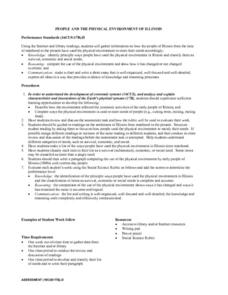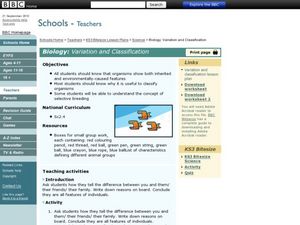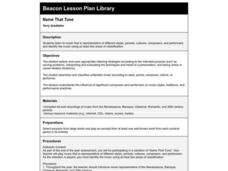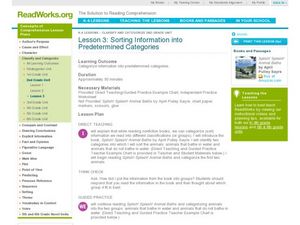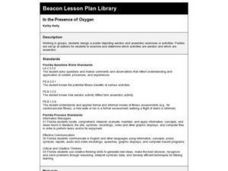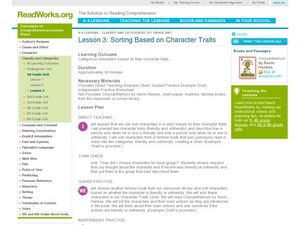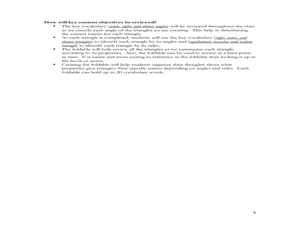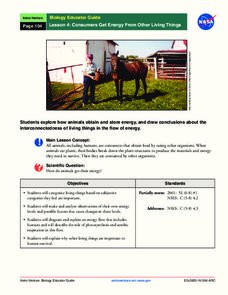Curated OER
Making Sense of Censorship
Students create their own ratings systems with which to classify current pop cultural fare as suitable or unsuitable for Students.
Curated OER
People and the Physical Environment of Illinois
Young scholars read about the settlement of Illinois from statehood to the present. They categorize different areas of need such as survival, economic and social. Students make a list of ways people used the physical environment in...
Curated OER
Lesson on Federalism
Eleventh graders study Federalism and delegated, reserved, and concurrent powers. They participate in a simulation in which they role-play Federalists and Anti-federalists debating which powers should be categorized as delegated,...
Curated OER
Air Quality and Transportation
Second graders study about air pollution and the effects it has on our Earth. Students tally cars on a sheet that has been categorized as follows: One person in car, two persons in car, or three or more persons in car. Students go to...
Curated OER
Biology: Variation and Classification
Students investigate classification of different animal groups. In this biology instructional activity students list characteristics of themselves and others they know to show differences and how they are classified. Students...
Curated OER
Vertebrates And Invertebrates
In this science lesson, pupils classify pictures into categories of vertebrates or invertebrates. After a class discussion, students divide into groups, and are given plastic baggies that contain photographs of each. The groups must...
Curated OER
Name That Tune
Fourth graders listen to different types of music, then categorize them into two different areas of classification.
Curated OER
Five a Day
Students look up and print definitions of fruit and vegatable. They write down their food intake for three days. They identify and categorize fruits and vegetables. They research how fruits and vegetables grow. They bring in their...
Curated OER
How Can Plants Be Sorted?
For this plant classification worksheet, students will observe a variety of different plants and categorize each plant by its flowers, leaves, and spines. This worksheet had 13 fill in the blank questions.
Curated OER
Sorting Into Predetermined Groups
Sort pictures of items into categories of at school and at the grocery store in a classification lesson plan. Kindergartners start by sorting pictures into categories of in the sky and in the ocean. Use the lesson plan for any story or...
Curated OER
Lesson 3: SortingInformation into Predetermined Categories
Second graders sort items into predetermined categories. In this sorting activity, 2nd graders learn the meaning of the word squirt before listening to a reading of the book, Splish! Splash! Animal Baths by April Pulley Sayre. They...
Read Works
Writing a Research Report
Transfer information from an outline into a well-developed research report. Using an already-written outline, model how to write an introductory paragraph and a body paragraph. Work through the conclusion as a class before allowing time...
Curated OER
In the Presence of Oxygen
Third graders, in groups, classify different activities as aerobic or anaerobic. They create posters displaying their categorizations and then take notes on each other's posters.
Curated OER
Sorting Based on Character Traits
Characters from a story can be sorted by their traits, just like shapes or objects can. First the children list several character traits on a chart, they read a familiar story, and then sort the characters by their friendly or unfriendly...
Read Works
Using Text Features to Find Information
If you are working on a research project, consider this resource. First, model how to use notes and text features to create an outline. Next, allow individuals to choose a topic and complete the same process that you showed them....
Curated OER
Manners and Mores of Washington's America
Middle schoolers explore the social policies of early America. In this etiquette lesson, students read George Washington's "110 Rules of Civility and Decent Behavior in Company and Conversation." Middle schoolers identify expectations...
Rainforest Alliance
Forests of Guatemala
With 90 percent of its land area covered in forests, Suriname, a country in South America, contains the largest percentage of forests throughout the world. Here is an activity that brings classmates together to learn about the...
Curated OER
Guetemala's Changing Forest
Eighth graders compare their local ecological zone to the tropical rainforest. In this natural ecology lesson, 8th graders complete an activity about the differences in ecological zones. They compare their biome to the Guatemalan...
Curated OER
The Circle of Life
Fourth graders examine how the different organisms living in an ecosystem affect one another. In groups, they research a specific ecosystem and present their findings to the class based on the type of organisms found in it. To end the...
Curated OER
Big Cat Locations
First graders explore different environments while studying the habitats of big cats. In this big cats lesson plan, 1st graders draw pictures of their favorite cats, learn about the areas where cats live, design a zoo habitat and...
Curated OER
Camouflage
First graders learn how plants and animals adapt to their environments. In this camouflage instructional activity, 1st graders watch a movie that explains animal camouflage, design a butterfly that blends into a classroom habitat,...
Curated OER
Making Big Cats' Web Pages
Students investigate the lives of big cats by creating a website. In this web design lesson, students examine web authoring software in pairs as they read books on big cats. Students share their web page creations with the...
Curated OER
Angles in Triangles
Eighth graders translate word problems using mathematical ideas. For this geometry lesson, 8th graders identify angles of triangles using equations and the triangle sum theorem. They create angles with a protractor and straight edge.
NASA
Consumers Get Energy From Other Living Things
How do plants and animals get their food? Learn about where energy comes from, how animals store energy, and aerobic respiration, in a lesson that allows scholars to diagram energy flows.



